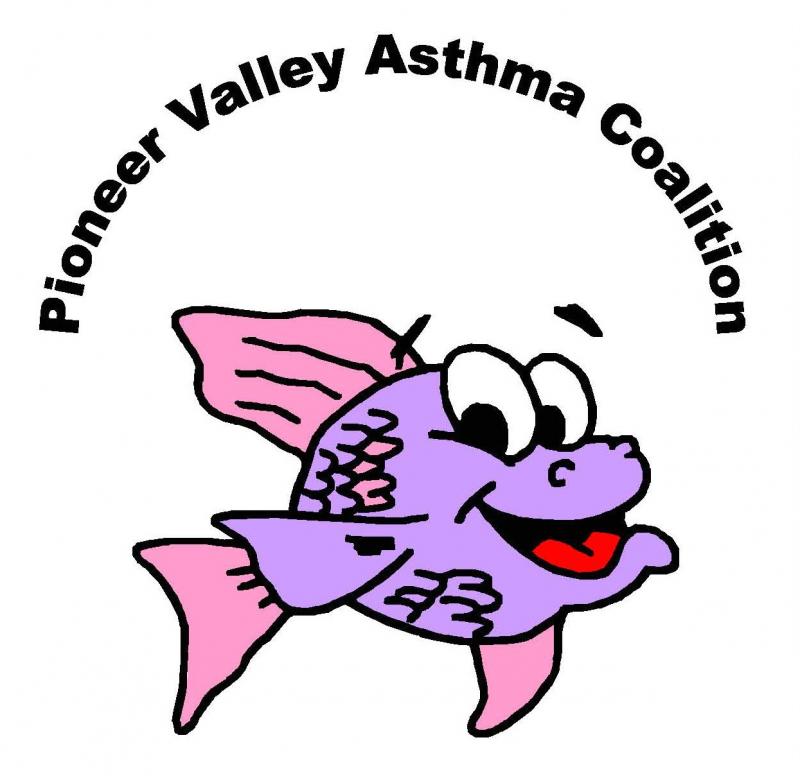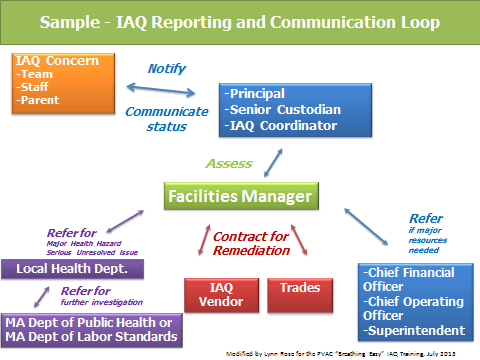Healthy Schools
PVAC meets quarterly on zoom. Sign up to get the latest updates on meetings, activities and advocacy actions.
Please contact us if you have more questions or would like to volunteer.
Breathing Easy-School IAQ Resource Guide
About this resource guide
In 2013-2014, the Pioneer Valley Asthma Coalition sponsored the “Breathing Easy” School Indoor Air Quality Training for three local school districts- Holyoke, Northampton and West Springfield. The goal of the training was provide school facilities staff with tools to create action plans for improving indoor air quality.
With the support an EPA Indoor Air Quality grant, we are able to provide the training materials and resource list for public use on this website. This training was based on the the EPA's Tools for Schools as modified by our Environmental Health Consultant.
INTRODUCTION: MAKING THE CASE FOR A SCHOOL IAQ PROGRAM
PVAC and Environmental Health and Safety Consultant Lynn Rose met with school district, local health department and other health agency staff in advance to explain the program and offer education on the links between IAQ, health and academic performance.
Key Messages
- Improved IAQ leads to improved attendance and improved academic performance
- Some districts only do emergency maintenance and not the preventative maintenance required to maintain healthy air
- Many IAQ issues are preventable
Presentation
ENVIRONMENTAL MANAGEMENT SYSTEMS AND INDOOR AIR QUALITY
Key Messages
- Identify, prioritize, prevent, resolve and monitor environmental health and safety issues
- A systems approach is important because it is
- Proactive, methodical and comprehensive
- Identifies potential impacts on people and the enviroment
- Develops environmental management plans to prevent, reduce or eliminate impacts/problems
- Helps address non-regulated issues such as IAQ and radon
- Assigns roles and responsiblities and establishes record-keeping
- Designate funding for activities
- Creates systems for issue identification, prevention, corrective action and follow-up
IAQ AND VENTILATION ASSESSMENT
Key Messages
- Ensure that occupants (maintenance staff, principals, teachers, cafeteria workers etc) know the conditions in their building and are involved in the assessment process
- Educate occupants on how to maintain the air quality in their workspace
- Develop a written complaint reporting, investigation and resolution process which includes training for everyone (teachers, staff, maintenance, principals, etc)
- Create preventative maintenance programs which enable the school to both prevent problems and identify existing problems that need to be addressed
IAQ Reporting and Communication Loop
MOISTURE AND MOLD
Overview
Key Messages
- Identify and correct the source of moisture immediately
- Assess the magnitude of the mold damage to develop a mitigation plan including
- what needs to cleaned versus disposed of
- who will mitigate it (e.g. in-house or contracted)
- how it will be done to minimize any further contamination
- how to protect occupants and workers during the mitigation process
- Know when to test and when not to
IAQ DURING RENOVATION WHILE OCCUPIED
Overview
Key Messages
- Prevention is the key here -
- Identfiy pollutants generated from construction processes and possible pollutant pathways before renovation
- Use these assessments to develop IAQ Plan to prevent impacts
- During and after renovation is when the most IAQ complaints are generated
- MA laq requires an IAQ plan in contract specifications for vendors doing revnovation while occupied
- Toxics reduction in contraction materials used during renovation will help meet these requirements
IAQ TESTING
Speaker
MaryBeth Smuts, Regional Air Toxicologist, EPA
Key Messages
- Investigate first--IAQ testing does not replace an investigation involving inspections and interviews
- Identify and mitigate known pollutant sources before IAQ testing
- Only test if you know what questions you are trying to answer and what information you are seeking
HAZARDOUS MATERIALS
Key Messages
- All schools have hazardous materials used for curriculum, maintenance and operations
- These products can and do impact IAQ
- Schools can reduce toxicity of these materials -- by choosing less hazardous products, processes and work practices
HAZARDOUS MATERIALS
Key Messages
- All schools have hazardous materials used for curriculum, maintenance and operations
- These products can and do impact IAQ
- Schools can reduce toxicity of these materials -- by choosing less hazardous products, processes and work practices
Key Messages
- Cleaning is for health, not just esthetics--you clean to remove allergens and biological contaminants
- Considerations include:
- the way you clean--eliminate work practices that can spread rather contain or remove contamination
- what you clean with--eliminate the products can contaminate the air
- frequency--ensure that you clean often enough to reduce allergens/contaminants
- ensure that spaces and surfaces are cleanable
Holyoke Public Schools Green Housekeeping Program
In collaboration with Healthy Holyoke, the Holyoke Public Schools is implementing a Green Housekeeping Program – investing in all all new cleaning products, supplies and equipment that meet green standards for performance, health and safety. PVAC has been involved in supporting this effort with the Healthy Holyoke - Prevention & Wellness Trust Fund project and past funding from the EPA.Holyoke has the highest asthma rates for school children in the state so this is a much needed and exciting new policy that will impact HPS students for years to come. Read the HPS Update to learn more.
PVAC worked with the Holyoke Health Center and other partners on the Healthy Holyoke Prevention & Wellness Trust Fund initiative to improve asthma outcomes in Holyoke.
Idle-Free Schools Initiative
Anti-Idling Signs are posted at all Springfield Schools
PVAC received word in August that signs were posted at all schools in time for the new school year.
Thanks to Superintendent Daniel Warwick and Director of Safety and Security Bill Baker for making posting the signs a priority.
We also want to thank ARISE, Mason Square Health Task Force and all our supporters for working with us in this successful collaboration. We will be working this fall on planning anti-idling educational activities for the coming school year.
Support By
Supported by grant from the Environmental Protection Agency.
For information on the EPA's work on Creating Healthy Indoor Environments in Schools, visit:
http://www.epa.gov/iaq/schools/
Environmenal Protection Agency Children's Center 2015 Webinar Series
http://www.epa.gov/ncer/events/#cehc-webinar
New England Green and Healthy Schools
EPA New England Green and Healthy Schools Update
New England Environmental Education Alliance 2015 Conference November 8th-10th


